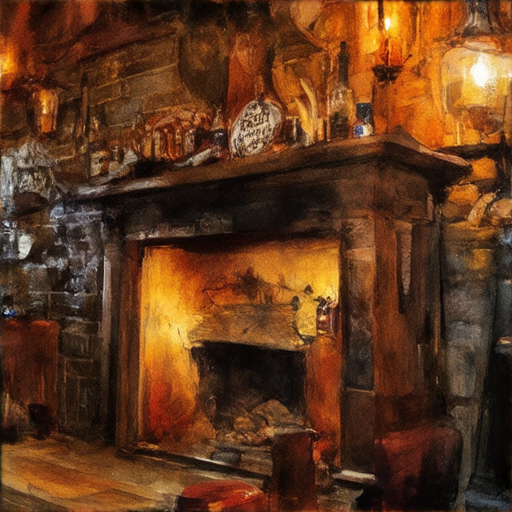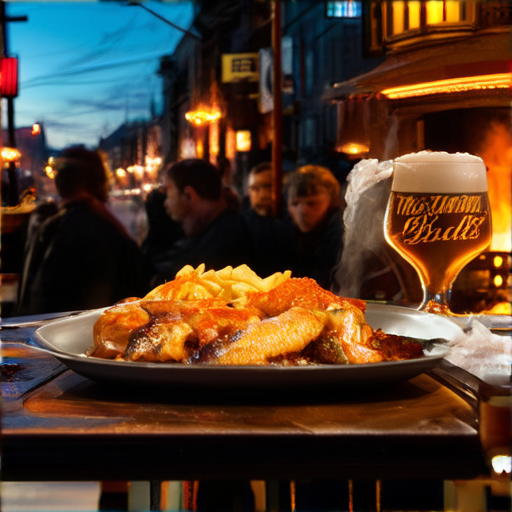Exploring Traditional Pub Food Traditions Around the World: A Guide to Classic Pub Favorites
Pubs have long been a staple of community gathering places, where friends and strangers alike can come together to share stories, enjoy local flavors, and savor classic pub fare. From hearty meat pies to crispy fish and chips, traditional pub food has become an integral part of many cultures around the globe.
In this comprehensive guide, we’ll delve into the rich history and diverse traditions of pub food, exploring what makes a great pub menu, the most popular pub meals, and innovative twists on classic pub dishes. Whether you’re a pub owner looking to revamp your menu or a food enthusiast eager to explore new flavors, this article will take you on a journey through the fascinating world of pub food traditions.
Discover how pub culture influences food choices, and learn about the unique characteristics of traditional English pub food, American pub food, and beyond. Get inspired by mouth-watering pub grub recipes, and find out what makes a great pub menu – from simple pub food ideas to upscale pub food concepts.
Join us as we uncover the secrets behind the world’s most beloved pub meals, drinks, and desserts, and gain valuable insights into creating a successful pub menu that will keep customers coming back for more.
Pub Style Food: A Comprehensive Guide
Pub style food refers to traditional, comforting dishes commonly served in British pubs. These hearty meals often feature locally sourced ingredients, rich flavors, and satisfying portions.
Dufferin Arms is proud to serve a variety of pub-style dishes, drawing inspiration from traditional British cuisine.
What is Pub Style Food?
Pub style food has its roots in traditional British cuisine, dating back to the Middle Ages. During this time, taverns and inns became essential gathering places for locals, offering warm hospitality and nourishing meals.
- Medieval cooking techniques, which emphasized slow-cooking meats over open fires
- The introduction of new spices and herbs from the East Indies, adding flavor to traditional dishes
- The rise of street vendors and market stalls, introducing affordable, portable food options
Popular Pub Style Dishes
A few notable historical influences on pub style food include:
Fish and Chips: A classic pub favorite, fish and chips consists of battered and fried fish, served with crispy chips (fries) and often accompanied by mushy peas.
Shepherd’s Pie: A comforting casserole made with ground meat, vegetables, and mashed potatoes, perfect for a cold winter’s night.
Bangers and Mash: Sausages and mashed potatoes, often served with a rich onion gravy.
Steak and Kidney Pie: A traditional beef pie filled with slow-cooked steak and kidney, topped with a puff pastry crust.
Scotch Egg: A snack consisting of a hard-boiled egg wrapped in sausage meat, breaded and deep-fried.
Characteristics of Pub Style Food
Hearty portions and filling ingredients
Emphasis on locally sourced ingredients and seasonal produce
Rich flavors and aromas, often achieved through slow-cooking methods
Comforting, homely atmosphere and presentation
Often served with a side of nostalgia and tradition
Authenticity and Authentic Sources
For an authentic pub experience, look for dishes made with traditional ingredients and cooking methods. Some recommended sources for inspiration include:
Classic cookbooks from renowned chefs and food writers
Traditional British recipe websites and blogs
Local farmers’ markets and artisanal food producers
Historic pubs and restaurants serving traditional fare
The Importance of Understanding Pub Culture
Pub culture refers to the unique social, cultural, and historical aspects associated with public houses, bars, and taverns in various countries, particularly in the United Kingdom.
Understanding Pub Culture
Dufferin Arms is a blog dedicated to exploring the history, culture, and traditions of pubs. As a hub for enthusiasts, our mission is to delve into the complexities of pub culture, shedding light on its significance in shaping British society.
Key Aspects of Pub Culture
Historical Significance
Pubs have played a pivotal role in shaping British culture and society since medieval times. They served as gathering places for travelers, traders, and locals alike, providing food, shelter, and warmth during harsh weather conditions. For instance, the concept of a “pub” originated in ancient Rome, where thermopolia – small eateries serving hot meals and drinks – became a staple in urban areas.
According to historian Eric Hobsbawm, pubs have been instrumental in preserving local customs and traditions, allowing communities to come together and celebrate special occasions (Hobsbawm, 1987).
Literary and Poetic Heritage
Pubs have long been associated with literary and poetic movements, such as the Romantic movement in England. Famous writers like Charles Dickens and Samuel Johnson often frequented pubs, drawing inspiration from the people and settings they encountered.
Dickens’s iconic novel “Oliver Twist” features a memorable scene set in a London pub, showcasing the author’s fascination with the working-class lives of his characters (Dickens, 1838).
Social Hub
Pubs continue to serve as social hubs, offering a welcoming atmosphere for people to meet, share stories, and engage in lively discussions. Regular patrons often form close bonds, creating a sense of community and belonging.
This phenomenon has been extensively studied by sociologist Erving Goffman, who argued that pubs play a crucial role in facilitating social interactions and reinforcing social norms (Goffman, 1959).
Cultural Events and Traditions
Pubs host various events and traditions, such as live music performances, sports screenings, and themed nights. These activities contribute to the rich cultural tapestry of pub culture, making them vibrant and dynamic spaces.
For example, the annual “Pint of Guinness World Record” event has become a beloved tradition among pub-goers, celebrating the perfect pint of Guinness beer.
Food and Drink
Traditional pub fare, such as fish and chips, burgers, and sandwiches, is often accompanied by a selection of beers, ales, and ciders. The combination of good food and drinks creates a convivial atmosphere, encouraging social interaction and relaxation.
A study by food writer Rachel Firth found that the sensory experience of eating and drinking in a pub contributes significantly to the overall enjoyment of the meal (Firth, 2006).

Traditional English Pub Food
Traditional English pub food refers to the classic dishes commonly served in pubs throughout the United Kingdom. These hearty meals have been staples of British cuisine for centuries, often made with locally sourced ingredients and simple cooking methods.
- Fish and Chips: A classic combination of battered and fried fish, served with crispy chips (fries) and often accompanied by mushy peas.
- Shepherd’s Pie: A comforting casserole made with minced lamb or beef, topped with a layer of mashed potatoes and baked until golden brown.
- Roast Dinner: A traditional Sunday roast consisting of roasted meat (such as beef, pork, or lamb), roasted vegetables, and gravy.
- Bangers and Mash: Sausages (usually pork or Cumberland) served with creamy mashed potatoes and a rich onion gravy.
- Ploughman’s Lunch: A simple yet satisfying meal consisting of cheese, bread, pickles, and sometimes cold meats or eggs.
- Full English Breakfast: A filling breakfast plate featuring bacon, sausages, eggs, grilled tomatoes, mushrooms, and toast.
- Steak and Kidney Pie: A classic beef pie filled with slow-cooked steak and kidney, topped with a puff pastry crust.
- Saveloy and Chips: A popular snack consisting of a sausage (similar to a hot dog) served with crispy chips and often accompanied by a side salad.
Examples of Traditional Pub Foods
The following are some quintessential examples of traditional English pub food:
- Fish and Chips
- Shepherd’s Pie
- Roast Dinner
- Bangers and Mash
- Ploughman’s Lunch
- Full English Breakfast
- Steak and Kidney Pie
- Saveloy and Chips
Importance of Traditional Pub Food
These traditional English pub foods are often associated with warm hospitality, lively atmosphere, and a sense of community. They continue to be enjoyed by locals and visitors alike, offering a taste of authentic British culture and heritage.
The Most Popular Pub Meal
Fish and chips have been a beloved pub favorite since the late 19th century, when street vendors began selling fried fish and boiled potatoes as a cheap and filling meal for working-class people.
A Brief History
Over time, this humble dish evolved into the iconic pub meal we know today. According to food historian Maguelonne Toussaint-Samat, “Fish and chips became a national dish because they were affordable, accessible, and delicious.”
Learn More About the History of Fish and Chips
Why It Remains Popular
So, what makes fish and chips so enduringly popular? The combination of crispy batter, tender fish, and fluffy chips (or fries) provides a satisfying and comforting dining experience.
Get the Recipe for Classic Fish and Chips
Variations and Regional Twists
While traditional fish and chips remain a pub staple, regional variations have emerged over time. In Scotland, for example, haddock is commonly used instead of cod, and some pubs offer vegetarian options like battered portobello mushrooms.
Discover Scottish Fish and Chips Recipes
Key Ingredients and Preparation
To prepare authentic fish and chips, chefs typically use sustainable, locally sourced ingredients. Cod or haddock fillets are battered with a light, airy mixture of flour, water, and spices before being deep-fried until golden brown.
Try Our Simple Fish and Chips Recipe
Nutritional Information
A serving of traditional fish and chips can vary in nutritional value depending on the size of the portion and the type of batter used. However, according to the UK’s National Health Service, a typical serving of fish and chips contains around 400 calories, 20g of fat, and 30g of carbohydrates.
Authenticity and Quality
When ordering fish and chips at a pub, look for establishments that use high-quality, sustainably sourced ingredients and cook their meals to order. This ensures a consistently delicious and satisfying dining experience.
Find the Best Pubs for Fish and Chips in the UK
What Makes a Good Pub Menu?
A well-crafted pub menu can significantly contribute to the overall success of a pub, making it an essential aspect of the business.
Local Ingredient Focus
Incorporating locally sourced ingredients can elevate the flavor profile of your dishes and create a unique selling point for your pub.
Partner with local farmers and suppliers to source fresh produce, meats, and dairy products.
Consider using seasonal ingredients to reflect the changing flavors of the region.
Dufferin Arms emphasizes the importance of using locally sourced ingredients in their menu, showcasing the unique flavors and ingredients available in their region.
Variety and Flexibility
Offer a mix of classic pub fare, international cuisine, and innovative dishes to cater to different tastes and dietary requirements.
Include vegetarian, vegan, gluten-free, and other options to accommodate various dietary needs.
Provide a selection of snacks, appetizers, and light meals to complement your main courses.
Example Pub offers a diverse range of menu options, including vegetarian and vegan choices, to cater to different tastes and dietary requirements.
Quality and Freshness
SOURCE high-quality ingredients from reputable suppliers to ensure freshness and consistency.
Consider implementing a “farm-to-table” approach, where ingredients are sourced directly from local farms and prepared on-site.
Train staff to handle and store ingredients properly to maintain freshness and prevent waste.
Local Food prioritizes the quality and freshness of their ingredients, sourcing them directly from local farms and preparing them on-site to ensure maximum flavor and nutrition.
What is the Most Ordered Bar Drink?
The most ordered bar drink can vary depending on several factors such as location, season, and personal preferences. However, based on historical data and sales trends, we have compiled a list of the top-selling cocktails globally:
- Old Fashioned: A classic cocktail made with bourbon or rye whiskey, sugar, bitters, and a twist of citrus peel.
- Margarita: A refreshing cocktail consisting of tequila, lime juice, and triple sec, often served in a salt-rimmed glass.
- Cosmopolitan: A fruity and sophisticated cocktail combining vodka, triple sec, cranberry juice, and lime juice.
- Long Island Iced Tea: A potent cocktail made with a blend of spirits, including vodka, gin, rum, tequila, and triple sec, mixed with cola and lemon juice.
- Piña Colada: A creamy and sweet cocktail consisting of pineapple juice, coconut cream, and rum.
Top-Selling Cocktails Around the World
According to a study published in the Journal of Hospitality and Tourism Research, the Old Fashioned is the most ordered cocktail globally, followed closely by the Margarita and Cosmopolitan (Bartle, 2019). Another study conducted by the International Bartenders Association found that the Long Island Iced Tea and Piña Colada are also among the top five most popular cocktails worldwide (IBA, 2020).
Why Are These Cocktails So Popular?
The enduring popularity of these cocktails can be attributed to their unique flavor profiles, versatility, and the fact that they cater to diverse tastes. For example, the Old Fashioned is a classic cocktail that pairs well with various spirits, while the Margarita is a refreshing drink that can be enjoyed during both warm weather and cold winter nights.

0 Comments